Do you have a question about the Uponor A3040654 and is the answer not in the manual?
Lists the primary features and functionalities of the snow melt control system.
Crucial warnings for safe installation and operation to prevent injury or equipment damage.
Details requirements for isolating and shielding the control from electromagnetic noise.
Guidelines for site prep, location, physical dimensions, and tool/material needs.
Instructions for pulling and preparing low-voltage wiring cables for the control unit.
Diagrams illustrating wiring for sensors, power supply, and external components.
Specifies requirements for selecting an external transformer for the control's power supply.
Illustrates wiring for alert outputs and the transformer/relay connections.
Instructions for properly mounting and wiring the outdoor sensor for accurate readings.
Procedures for mounting the slab sensor on pipes or in immersion wells.
Details for conduit connections and testing sensor wiring resistance.
Steps to verify the control's power supply voltage.
Procedure to test control relays and verify correct wiring to snow melting equipment.
Explains modes like Max Heat, Test, Purge for manual system control and testing.
How to manually disable the snow melting system until reset.
Configuration of physical switches on the control for access level management.
Description of the control's display screen, fields, and touch controls.
Explanation of the information shown in the operational and status display fields.
Definition of symbols and icons used on the control display.
How to access and navigate through the control's programming menus.
Instructions for adjusting settings using the control's interface.
Details on installer vs. user access levels and how to change them.
Description of system parameters displayed in the first part of the View menu.
Description of additional system parameters displayed in the second part of the View menu.
Defines settings for Melting, Idling, Manual Melt Run Time, and other temperature parameters.
Information on tracking system operation hours, cycles, and temperature extremes.
Settings for units (F/C) and display backlight behavior.
Access to system information, test functions, and error history.
Details on manually controlling relays, pump, and boiler during testing or operation.
Configuration of how long manual overrides remain active before returning to auto.
Choosing the operating mode and configuring snow/ice and slab sensors.
Configuration of EconoMelt and Slab Protection features for optimal operation.
Selection of boiler type and modulation characteristics.
Settings for modulation delay, motor speed, and boiler differentials.
Advantages of snow melting systems and basic operation principles.
Importance of slab temperature and sensor use for cost-effective snow melting.
How the system heats the slab to melt snow or ice, triggered by sensors or manual input.
How to manually start the system and its timed shutoff behavior.
Operation based on Pavement Snow and Ice Sensor detecting moisture and temperature.
Using EconoMelt for manual snow removal followed by automated melting.
Operation using Aerial Snow Sensor with timed stop for efficient melting.
Setting extra melt time for areas that dry slower after initial melting.
Pre-heating the slab to reduce start-up delay, recommended for specific applications.
Automatic shutdown during warm weather to conserve energy.
System shutdown in extreme cold to prevent heat loss exceeding capacity.
How to disable the system for extended periods using the Away Key.
Preventing concrete cracking by limiting temperature differentials.
Categorizing system operation for electric or hydronic, dedicated or non-dedicated boilers.
How the control operates electric heating cables via PWM cycle.
Operation of hydronic systems with non-dedicated boilers.
How the control manages dedicated boilers, including different boiler types and targets.
Operation of a simple on/off boiler for maintaining target temperatures.
Control of modulating boilers via analog signals for precise firing rate adjustment.
Methods for communicating boiler targets to compatible boiler control systems.
Automatic pump operation every three days to prevent seizure in hydronic systems.
Setting the auxiliary relay for system pump or alert output functions.
Steps to follow when an error occurs, including identifying and solving error codes.
Error indicating the control reached maximum melt time due to system failure.
Covers short circuit and open circuit errors for outdoor, supply, and slab sensors.
Table of common symptoms, their causes, and corrective actions for system troubleshooting.
Lists of adjustable settings across various menu categories for quick reference.
Details on control type, weight, dimensions, power, sensors, and optional components.
Lists the primary features and functionalities of the snow melt control system.
Crucial warnings for safe installation and operation to prevent injury or equipment damage.
Details requirements for isolating and shielding the control from electromagnetic noise.
Guidelines for site prep, location, physical dimensions, and tool/material needs.
Instructions for pulling and preparing low-voltage wiring cables for the control unit.
Diagrams illustrating wiring for sensors, power supply, and external components.
Specifies requirements for selecting an external transformer for the control's power supply.
Illustrates wiring for alert outputs and the transformer/relay connections.
Instructions for properly mounting and wiring the outdoor sensor for accurate readings.
Procedures for mounting the slab sensor on pipes or in immersion wells.
Details for conduit connections and testing sensor wiring resistance.
Steps to verify the control's power supply voltage.
Procedure to test control relays and verify correct wiring to snow melting equipment.
Explains modes like Max Heat, Test, Purge for manual system control and testing.
How to manually disable the snow melting system until reset.
Configuration of physical switches on the control for access level management.
Description of the control's display screen, fields, and touch controls.
Explanation of the information shown in the operational and status display fields.
Definition of symbols and icons used on the control display.
How to access and navigate through the control's programming menus.
Instructions for adjusting settings using the control's interface.
Details on installer vs. user access levels and how to change them.
Description of system parameters displayed in the first part of the View menu.
Description of additional system parameters displayed in the second part of the View menu.
Defines settings for Melting, Idling, Manual Melt Run Time, and other temperature parameters.
Information on tracking system operation hours, cycles, and temperature extremes.
Settings for units (F/C) and display backlight behavior.
Access to system information, test functions, and error history.
Details on manually controlling relays, pump, and boiler during testing or operation.
Configuration of how long manual overrides remain active before returning to auto.
Choosing the operating mode and configuring snow/ice and slab sensors.
Configuration of EconoMelt and Slab Protection features for optimal operation.
Selection of boiler type and modulation characteristics.
Settings for modulation delay, motor speed, and boiler differentials.
Advantages of snow melting systems and basic operation principles.
Importance of slab temperature and sensor use for cost-effective snow melting.
How the system heats the slab to melt snow or ice, triggered by sensors or manual input.
How to manually start the system and its timed shutoff behavior.
Operation based on Pavement Snow and Ice Sensor detecting moisture and temperature.
Using EconoMelt for manual snow removal followed by automated melting.
Operation using Aerial Snow Sensor with timed stop for efficient melting.
Setting extra melt time for areas that dry slower after initial melting.
Pre-heating the slab to reduce start-up delay, recommended for specific applications.
Automatic shutdown during warm weather to conserve energy.
System shutdown in extreme cold to prevent heat loss exceeding capacity.
How to disable the system for extended periods using the Away Key.
Preventing concrete cracking by limiting temperature differentials.
Categorizing system operation for electric or hydronic, dedicated or non-dedicated boilers.
How the control operates electric heating cables via PWM cycle.
Operation of hydronic systems with non-dedicated boilers.
How the control manages dedicated boilers, including different boiler types and targets.
Operation of a simple on/off boiler for maintaining target temperatures.
Control of modulating boilers via analog signals for precise firing rate adjustment.
Methods for communicating boiler targets to compatible boiler control systems.
Automatic pump operation every three days to prevent seizure in hydronic systems.
Setting the auxiliary relay for system pump or alert output functions.
Steps to follow when an error occurs, including identifying and solving error codes.
Error indicating the control reached maximum melt time due to system failure.
Covers short circuit and open circuit errors for outdoor, supply, and slab sensors.
Table of common symptoms, their causes, and corrective actions for system troubleshooting.
Lists of adjustable settings across various menu categories for quick reference.
Details on control type, weight, dimensions, power, sensors, and optional components.
| Model Number | A3040654 |
|---|---|
| Brand | Uponor |
| Voltage | 24V AC |
| Display | LCD |
| Temperature Range | 5°C to 35°C |
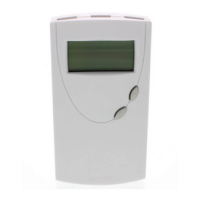



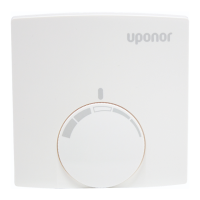
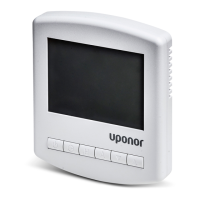
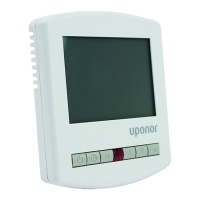
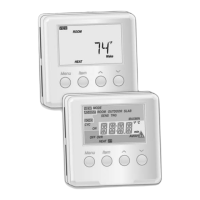
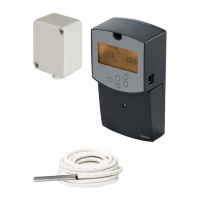
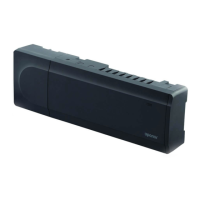

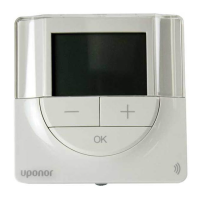
